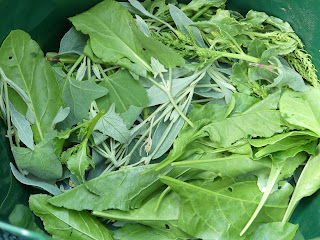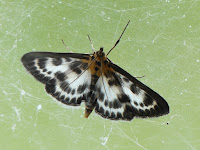Having been a Bushcraft Magazine reader for some time I finally got to meet Carol Hunt, who supplies a lot of the foraged food articles and the like, for the said publication at the May Meet in Kent.
As part of my work sabbatical I had dawn up a sort of rough bucket list whilst planning it, and sorting something with Carol was on that list. Now this is my fourth forage in eight weeks with the others being in differing locations with Joe O'Leary, John Rentsen (Forage London) and Fraser Christian (with the last three being on a 1-2-1 basis), and all good experience to go with my ongoing Paul Kirtley Tree and Plant masterclass learning.
I'd chatted to Carol at the Meet and I loosely arranged a programme and a meeting place (not too far from my recent Elmley reserve visit) via email, text and social media and took it from there...

I met up a little way through the Dartford Tunnel and I had a little look round as I was early. When Carol pulled up I mentioned that I'd bought a few provisions and a little equipment with me, even a towel in case Cat Tail harvesting was to happen. Before we started Carol offered me a caremalised Grasshopper to try from a tub which Will Lord had given her (I think his dad John got them in Japan). They weren't too bad but a quick swill with water did help the last pesky bits of exoskeleton wash away.
Carol suggested that we do a two centred foraging walk, one that started near the area where we were parked, which was by a farm and then work the perimeter of a field and an area just beyond, and then re-locate at an estuary which I was more than happy with.
We chatted about regular names, local names, edibility, medical uses and anything in between. As well as snapping plants (and insects) I saw I soon had to dive for my notepad as I was seeing varieties of plants that were new to me, and information that my pea brain would perhaps not hold until I got home. I was rather taken by this rather fine example of Fat Hen which photographed rather nicely, and the well spaced Jelly Ear on this Elder.

After scoping the field margin we made our way through a gate into a coppiced section of Edible Chestnut wood to the other side.
Carol pointed out how much nearer the chalk was on this side of the wood and of course the aspect was different too.
I learnt about yet more plants; some I hadn't seen before, and some that I was seeing for the first time this year. Interestingly I thought the flower on the left was White Campion but my cursory glance hadn't noticed that it was the slightly plumper Bladder Campion. Another moment to remind myself to slow down and be more studious.
We also saw an umbellifer that we couldn't quite nail, well at least not enough to nail the name 100% so I have to look this up. The foliage to the right is one of the new species to me which is Vervain.
One easily recognised umbellifer was Hogweed and I tried the seeds for the first time. It is said that it tastes somewhere between burnt Orange and Cardamon and I got the former. We did find several Hogweed plants that had rather larger than expected stems that you might expect...
And two more selected to finish off with, on the left Hops which are of course associated with Kent, and a non-edible in the form of Black Bryony. We decided to call it a day in this location to allow us time to drive to the second location and forage...It was later than either of us realised.
Carol spotted this unusual grass as we approached the cars and the shimmery look to it turned out to be hundreds of little winged insects! I let some land on my arm and they weren't midges, but some more investigation is needed.
We got in our cars and we quickly swopped rolling Kentish countryside, for a flat Kentish estuary a short distance away, and squelchy ground of a different kind.
As I live in a fairly similar place to the first location I did have some knowledge and experience of some of the flora, but with a few exceptions I was on a steep curve at the second. Prickly Lettuce, the aromatic Sea Wormwood...
Perenneal Rocket and Sea Spurrey...
Sea Purslane and Sea Lavender...
And Orache were all added to the memory banks. Incidenatlly I asked if Orache was pronounced 'Orache' or 'Orache' and it's 'Orache' just so you know. I'll be adding a lot of these to my #treeplantid photo album on Facebook.
There was one plant I knew but haven't foraged since I was a kid living in Skegness. This is Glasswort which is usually known as Samphire. You can buy it in supermarkets but it really can't hold a candle to the real thing which is juicy and gives you a satisfying salty taste of the sea. To be honest I couldn't get over it as I had an extended childhood flashback.
After we'd harvested some of the stuff we needed from the above list (plus a few tender Sea beet leaves we found in a sheltered spot) we had a quick look a little way inland. As well as seeing the plants and trees we did have a brief burst from a Cuckoo, as I did at Elmley the other day.
And this was our haul so without further ado it was on with the prep. Carol had come prepared with the necessary extra ingredients but we used my stove and pan.
Whilst we sorted the food we shared a concoction that she had made with just three ingredients and I'm pleased I worked out two and highlighted one ingredient that you might expect but that wasn't added.
Lunch came together smoothly and as we cooked several intrigued walkers came over to see what we where doing and some had a real chat.
Venison sat atop the Tom Yam foraged greens on a bed of noodles. Sadly I had to go easy on the venison due to my iron man status and just had a bit more than a taste.
We had a few greens left over so they got wilted briefly in the pan and had a very faint Tom Yam taste but it was more like a hint of seasoning or stock than a full blown taste. We'd chatted away and again when I checked the time it was way later than either of us realised so we tidied up and headed off. I was expecting to be in the countryside so the estuary visit was a nice surprise which lead to a great bit of food and an up close re-acquaintance with Samphire.




















































